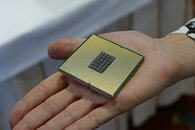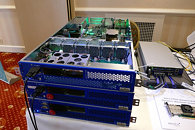Monday, October 12th 2015
Qualcomm Announces its First Socketed Enterprise CPU
Qualcomm, which holds a ton of ARM SoC patents, and put them to good use with its Snapdragon line of SoCs for smartphones, tablets, and convertible notebooks, is foraying into enterprise computing market. The company is ready with its first prototype of a 24-core high-performance CPU based on the 64-bit ARM machine architecture. ARM-based processors are picking up momentum in the server and micro-server markets owning to their low cost, low cooling requirements, and high energy-efficiency; and Qualcomm wants a slice of that pie. Most enterprise Linux and FreeBSD distributors have versions of their server operating systems for the 64-bit ARM architecture, as do most popular server software providers.
The prototype 24-core CPU is socketed, and ships in a large land-grid array (LGA) package, much like Intel's Xeon chips. The first production chips will have a lot more than 24 CPU cores, said Qualcomm senior vice president Anand Chandrasekhar. As a proof of concept, Qualcomm assembled three server blades using these chips, which were running Linux with a KVM hypervisor, streaming HD video to a PC using a LAMP stack (Linux + Apache + MySQL + PHP) built with OpenStack. Qualcomm's target consumers are big Internet companies like Google and Facebook, which purchase hundreds of thousands of CPUs each year to cope with growing user- and content-traffic.
Source:
PC World
The prototype 24-core CPU is socketed, and ships in a large land-grid array (LGA) package, much like Intel's Xeon chips. The first production chips will have a lot more than 24 CPU cores, said Qualcomm senior vice president Anand Chandrasekhar. As a proof of concept, Qualcomm assembled three server blades using these chips, which were running Linux with a KVM hypervisor, streaming HD video to a PC using a LAMP stack (Linux + Apache + MySQL + PHP) built with OpenStack. Qualcomm's target consumers are big Internet companies like Google and Facebook, which purchase hundreds of thousands of CPUs each year to cope with growing user- and content-traffic.



37 Comments on Qualcomm Announces its First Socketed Enterprise CPU
and then im the one thatanyway, you are all making a big fuss out of nothing, just because the product now also comes in a socket-able sku doesnt mean it will gain much more traction that it already has.
this is server grade material, for this to become part of a home grade pc developers need to target it, x86 / x86-64 will remain the goto platform for the coming years, that is unless developers start targeting linux+arm. and normally the people who do target that environment dont care about optimizing for it (as long as it works, android comes to mind with the dalvik userspace vm), while those who target x86* normally "care a bit more" about the release/production performance of the software. also x86* binaries tend to be smaller and easier to obfuscate.
I would just like to add that on Linux OSes the size of the programs is even smaller because the mostly open-source apps use the same libraries and that makes them small, no need to write the code again and reinvent the wheel or take up the space on a drive. Again all of this is possible because of open-source software.
Home PCs are intended for multi-porposes and that is where the CISC is better than RISC.
I think you didn't read my two posts and Human Smoke's argue. Qualcomm is big but entering the servers market isn't easy and I talked about NVIDIA because they are the only company entered the servers market in the last ten years and survived. For a company to enter supercomputers and data centers processes market they need huge support from software companies. When I talked about CUDA as example. NVIDIA spent the last five years pushing it in every where, now they have comfortable position in the market and alot of support from software companies and programmers but still they can't make their own platform.
It's nice to have someone to keep the conversation on (thanks for that) but it's 1AM here.
1) one company "makes sure" users can only use their closed source software on their fpgas and vice-versa, another uses an opencl backed sdk, instead of vhdl, to program the fpgas
2) one company sources the fpgas from altera and makes the boards in-house, afaik the other company also does not own any fabrication, so it sources their fpgas from tsmc and also makes boards in-house, granted the gpu design came from in-house.
still, you can do a lot more and faster on a real fpga than on a gpu, and being bound to a walled garden that you cant control (nor exit after entering without losing money) is not the best option. and if you are going to bring rendering into play, note that one solution allows easy rendering and processing to be done on any opengl/vulkan enabled gpu, the other doesnt even support a proper opengl pairing (mem copy to host is required for processing), i will leave you to guess which is which
In return, Qualcomm would gain:
-an excellent Jim Keller-designed Zen x86 core CPU, about to be released, that was designed to scale from the largest datacentre CPU clusters to the smallest low-power x86 devices. Oh, and the only other x86 license currently available.
-a world class GPU core in the form of the Radeon Graphics divison, which would allow them to include additional advancements into their SnapDragon ARM chips, as well as break into the HPC GPU market place
-a footprint in the gaming world, which could be parlayed into better gaming chops for portable (either x86 or ARM) chips in Android phones, etc.
This, or an Apple buyout, for similar reasons, would make the most sense. A Microsoft buyout would essentially turn Microsoft into Apple, but with an x86 license to boot, and possibly a monopoly over gaming hardware for some time.(bold italics mine)
Perhaps nVidia should merge with/buy out AMD. Then they'd have x86 as well as all the patents/technology from the Radeon division.
1- no one will allow the marriage of the only two discrete graphics chips makers in the world.
2- NVIDIA is strong but not strong enough to carry AMD's problems. And if they are smart they have learned the lesson from AMD +ATi.
Here's the benchmarks for those access points: XR630/XR520
In other news the thing is with this QCA CPU here in the article, for windows the server apps will need to be recompiled so this is linux only right now... MS is prolly gonna drag-ass on this, killing the potential for this to succeed. Windows servers are gaining marketshare due to hyper-v being included in the OS cost instead of paying a lot for vmware/commercial Xenserver/Commercial Virtuozzo instead of openvz. OpenVZ,free Xen, and KVM hypervizors do not have as many features as hyper-v does right now.*
Also OVZ and CVZ are both containers rather then full hypervisors. So true hypervizors you will be limited to FZ and KVM.*
* = Server hypervizors used for web hosting and NOT desktop hypervizors like VB parellels, etc..